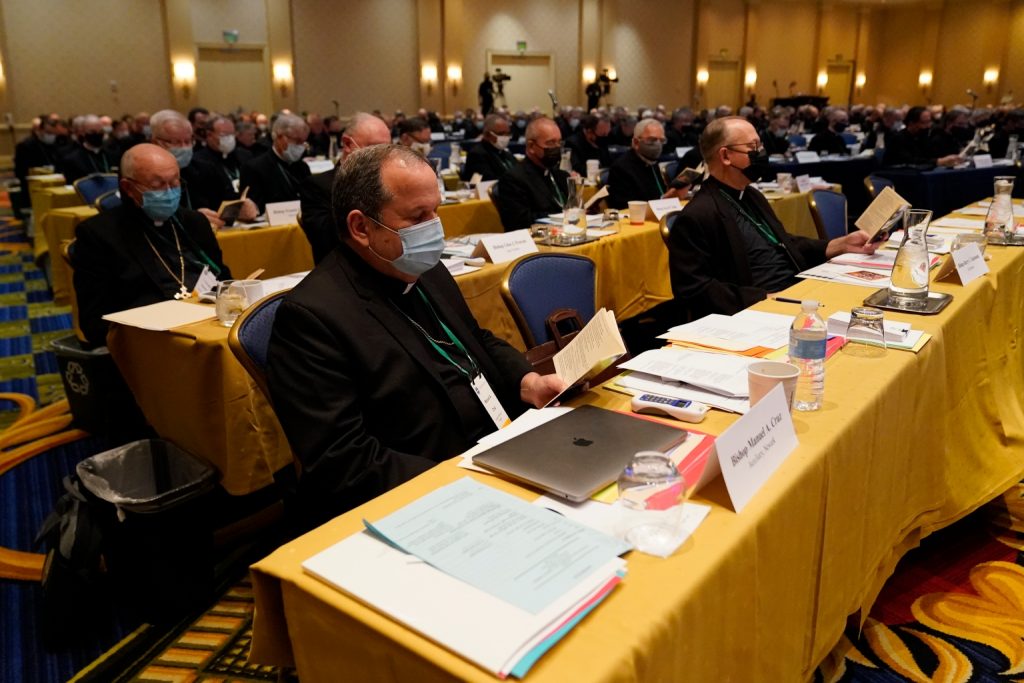BALTIMORE – At one point during this week’s fall plenary of the U.S. Conference of Catholic Bishops, Archbishop John Wester of Santa Fe ran into Bishop Kevin Rhoades of Fort Wayne-South Bend in an elevator and thanked him for his hard work on the Eucharist document.
“I wouldn’t have been able to do that on Zoom,” Wester told Crux.
The sentiment is one many bishops share. They feel that the in-person nature of this year’s fall general assembly paid dividends after two years away – both for fraternity and business.
“You just can’t replace face to face conversations for productive means of carrying on the business of the conference,” Archbishop Paul Etienne of Seattle told Crux.
Bishop Robert Brennan of Columbus, the bishop-designate of Brooklyn, told Crux that informal conversations at breaks or in the hallways “spur other ideas and then you have the broader conversations in the meetings.”
Bishop Nicholas DiMarzio of Brooklyn noted that being in-person is a “boost” for comradery.
“Many of the bishops are by themselves and they don’t see other bishops that often, but when we get a chance to come together, old friendships, people who were on committees together, they see one another and it’s a great time,” DiMarzio said.
The public sessions too, provided other moments that weren’t possible over Zoom – standing ovations, the collective gasp from the bishops after a committee chairman election was decided by one vote, and the laughter associated with a vote on whether to serve ice cream during break.
On the business front, it was clear that being in person had an impact on the bishops coming to a consensus on the verbiage, message and purpose of the much-anticipated Eucharist document, which overwhelmingly passed Wednesday morning with 222 bishops voting in favor, eight voting against, and three abstaining.
When the document first came up at the June plenary via Zoom it sparked a contentious debate among the bishops with no opportunity for off camera conversations. In the five months since the bishops met as regional conferences and provided recommendations to the USCCB doctrinal committee, chaired by Rhoades, that were used to draft the document.
Fast forward to Wednesday, and only a few bishops commented on the draft before the vote. The whole discussion and vote lasted about 15 minutes. Wester said part of the reason for the lack of discussion was the opportunity to talk through differences in private sessions ahead of time.
“I could tell from the executive session there wasn’t going to be anything huge,” Wester said. “We took it up right away on Monday and that’s where I was listening to see who’s going to say what. It was surprisingly quiet and peaceful and tranquil and all that.”
Presentation on the Synod of Bishops on Synodality
One of the more fruitful discussions during the public sessions was Wednesday afternoon on the 2021-2023 Synod of Bishops on Synodality. Bishop Daniel Flores of Brownsville, the incoming chair of the USCCB doctrinal committee, led the discussion with a presentation on the synodal process, which was launched by Pope Francis on October 10, and a week later at the local level by bishops from all over the world, including the U.S.
The goal of the diocesan discernment process, Flores said, “is not the production of a 10-page report, but to focus on listening and discernment.” He talked about the importance of the consultation process reaching the alienated, the marginalized, the elderly, as well as migrants and those who don’t attend church or practice the faith.
The elderly is a particularly difficult group to reach, because it’s difficult to gather them together, Flores said, “but we have to be flexible on how we do the consultation” by possibly talking to them individually, or asking them only one or two questions.
Flores, who has a strong presence on Twitter as @bpdflores, further encouraged the bishops to “invite our people to a time of listening and consultation, reaching out to people who often don’t sit on our pews, read our parish bulletins, our Facebook pages, or follow our tweets.”
That said, he also emphasized that “prayer and adoration are the sustaining force of the path forward,” insisting that the synod is a process of ecclesial discernment that unfolds in prayer, adoration, and dialogue with the people of God.
Flores also highlighted that both the website of the Vatican’s synod office and that of the USCCB have several resources available for those who haven’t started or fallen behind.
After Flores’s presentation, about 10 bishops weighed in with personal insights into how the synodal process has unfolded in their diocese, or suggestions for bishops to look into.
Cardinal Joseph Tobin of Newark reminded his fellow bishops that “to see what people believe is important,” noting that if they do the synodal process right as a collective “then we’re going to have some very important resources in that sort of discernment.”
Archbishop Gustavo García-Siller of San Antonio spoke about the impact the synod is already having across his archdiocese.
“We know the Holy Spirit is working because he’s building up already bringing us to unity,” García-Siller said.
Archbishop Alexander Sample of Portland spoke about his approach to the synod of beginning with deep prayer across his archdiocese. Sample then, however, pivoted and connected that synodal approach in his archdiocese to the beginning of the fall plenary, which speaks to the importance of the bishops coming together in person.
“The experience for me of this meeting is very different in that we started this meeting in prayer and we gathered in prayer together, before the lord, seeking his guidance for our time together,” Sample said. “For me, I felt a different atmosphere at this meeting because we took that time in prayer to invite the lord into what we’re doing.”

